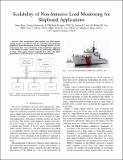| dc.contributor.author | Paris, James | |
| dc.contributor.author | Remscrim, Zachary N. | |
| dc.contributor.author | Douglas, Keith | |
| dc.contributor.author | Leeb, Steven B. | |
| dc.contributor.author | Cox, Robert W. | |
| dc.contributor.author | Galvin, Scott T. | |
| dc.contributor.author | Coe, Steven G. | |
| dc.contributor.author | Haag, Jennifer R. | |
| dc.contributor.author | Goshorn, J. Andrew | |
| dc.date.accessioned | 2015-05-15T14:42:18Z | |
| dc.date.available | 2015-05-15T14:42:18Z | |
| dc.date.issued | 2009 | |
| dc.identifier.uri | http://hdl.handle.net/1721.1/97005 | |
| dc.description.abstract | The non-intrusive load monitor has been demonstrated as an effective tool for evaluating and monitoring shipboard electro-mechanical systems through analysis of electrical power data. A key advantage of the non-intrusive approach is the ability to reduce sensor count by monitoring collections of loads. This paper reviews trade-offs that affect the likely performance of the NILM in a real world environment. | en_US |
| dc.description.sponsorship | Massachusetts Institute of Technology. Sea Grant College Program; Grainger Foundation; National Science Foundation (U.S.); United States. National Aeronautics and Space Administration; United States. Coast Guard; United States. Office of Naval Research. Electric Ship Research and Development Consortium; NAVSEA; University of North Carolina | en_US |
| dc.language.iso | en_US | en_US |
| dc.publisher | Massachusetts Institute of Technology. Sea Grant College Program | en_US |
| dc.relation.ispartofseries | MIT Sea Grant Technical Reports;MITSG 09-23 | |
| dc.title | Scalability of Non-intrusive Load Monitoring for Shipboard Applications | en_US |
| dc.type | Technical Report | en_US |
